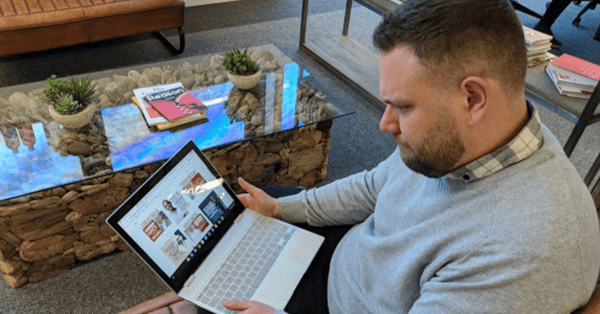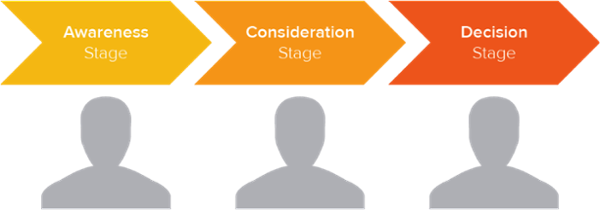Video marketing is, without a doubt, one of the most powerful marketing strategy tools to take into...
The buyer’s journey is a process where individuals become aware of a problem, they consider and evaluate their options before deciding to purchase a product or service. It’s to make sure you reach out to prospects in the right way at the right time. Thanks to a quick Google search, the buyer’s journey has now evolved.

Here’s why each stage is vital to successful inbound marketing campaigns.
- Awareness
- Consideration
- Decision
- Delight
- Why you should care about the buyer’s journey
- How far should you trust the buyer’s journey?
Awareness
Here, the buyer realises they have a problem. They’ll show symptoms of an issue and their research at this stage is to understand their problem so they can define it. Right now, they won’t look for a solution.
Their problem (or pain point) is why they search for a solution. This could be your product or service but there’s a catch - the individual has no interest in brand-specific messages. They just want a definition of their symptoms. In a nutshell, throw a tonne of useful content at the reader to nudge them to the next stage.
What sort of content is appropriate here?
- Thought leadership eBooks.
- Educational blogs.
- Industry reports and analysis.
- Downloadable guides.
- Troubleshooting tips.
- Infographics.
Consideration
Now, the individual is aware of their problem and has defined it. They want to understand what’s the best product or service to help them solve their issues or pain points. It might be a piece of software, a method of working or even buying a product. Whatever it is, they want something to suitably fulfil their needs.
They’re still fairly uninterested in the end provider - they don’t want to hear about you just yet. Before speaking to your brand or making a purchase, they want to work through a list of solutions.
What sort of content is appropriate here?
- Podcasts.
- Webinars.
- How-to videos.
- Online Q&As.
- Technical blogs.
- Expert eBooks with actionable steps.
- Downloadable tools.
Decision
Now the buyer has decided on a solution. They know how to solve their problem and researched specific products or services to do just that. Here, they’ll compare and whittle down their options to a list - ultimately making a purchase decision.
If you’ve helped them reach this far with your content, then they’re far more likely to trust you if you’ve satisfied them enough. The buyer also looks into who can provide this solution, so now is when you can finally shout about your brand messaging and detailed information about your processes.
What sort of content is appropriate here?
- Free trials.
- Demos.
- Competitor comparisons.
- Client case studies.
- Product datasheets.
- Price guides.
- Service level agreements.
Delight
Finally, you can exceed a customer’s expectations to create a positive experience with your brand.
It shows you’ve gone above and beyond to create a memorable experience through things like gifts, promotions, discounts or even spontaneous outreach so they become raving promoters about your brand. By fostering this emotional connection, customers are more likely to return and be loyal to you in the long-term.
The best part? Delighting them can result in buyers promoting your offering to others.
What sort of content is appropriate here?
- Follow-up emails.
- SMART content.
- Surveys.
- Customer spotlight downloads.
Why you should care about the buyer’s journey
Buyers’ behaviour has changed. They now hold all of the power, not the seller. Now everyone has a world of information at their fingertips through their smartphones, buyers are more educated than salespeople. They no longer respond to marketing strategies of 20 years ago.
- 86% of people skip TV ads.
- 44% of direct mail isn’t ever opened.
- It takes 50 cold calls to get one appointment.
- Leads from outbound marketing only close at 1.7%.
But it’s important you approach a prospect at the right time. This is essential to conversion. Everyone is searching online these days so you need to make sure your business is visible and engages with the buyer at different stages of their journey.
- 61% of people research products and services online.
- 46% of people read blogs more than once a day.
- 57% of the sales cycle is complete before a prospect reaches out to a sales rep.
How far should you trust the buyer’s journey?
The truth is, breaking down the modern-day purchasing process is incredibly simplistic. You can’t assume anyone will follow these stages in a linear path as that’s not how every single consumer’s brain works.
The buyer’s journey will be staggered and could be repeated quite often. Think of it as a playground. Kids don’t always go from the swing to slide to the seesaw in that order. It applies to buyers as well - they can go from a particular stage to another in any order. It could go from Awareness to Decision and then Consideration.
So if the buyer’s journey isn’t linear and no longer a flywheel, how can you structure your content so that it’s effective? What can you implement into your strategy? You can make sure that you create a vault of content from all of the different buyer’s journey stages so that you give buyers a choice. Give them the freedom to move in any order they choose.
When you properly align your content, the buyer’s journey does work and you’ll understand customers a lot better. Need more convincing?
- 71% of B2B research starts with a generic search rather than looking for a particular brand.
- According to Forrester, 80% of the buying process will occur without direct human interaction by 2020.
- 65% of buyers spend more than 16 minutes comparing before making a decision-stage purchase.
- Sales opportunities increase by more than 20% when leads are nurtured with targeted content offers.
You should categorise your messages and understand what you already do well and where you might not be heard at all. Once you’re aware of the gaps, you can fill them and create a huge content library which meets your persona’s pain points head-on. Now you’re probably wondering whether this actually works in real-life situations.
See what a typical year in inbound looks like
Producing content that revolves around the buyer’s journey is just one part of the strategy. It’s what helps create successful campaigns - and we’ve got a guide to back it up. Our download will give you a visual representation of what to expect throughout the year when you implement inbound marketing.
It shows what to expect when content is created, how to amplify it and more. To get your free copy, click on the link below.


